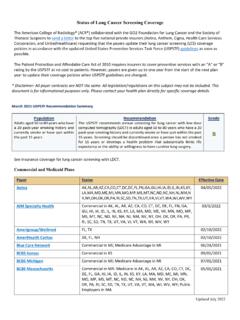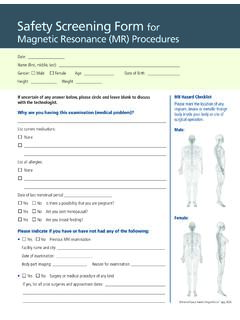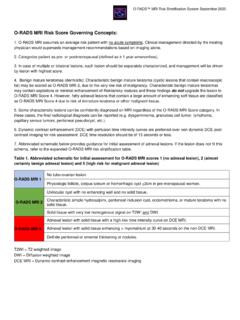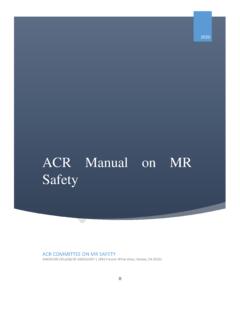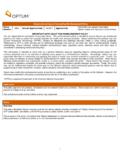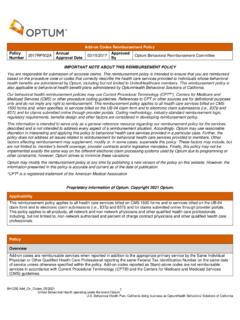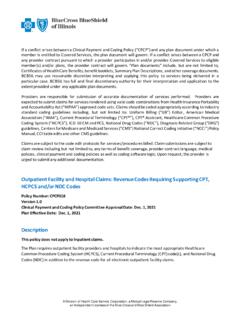Transcription of ACR PRACTICE PARAMETER FOR COMMUNICATION OF …
1 PRACTICE PARAMETER 1 COMMUNICATION Diagnostic Imaging The American College of Radiology, with more than 30,000 members, is the principal organization of radiologists, radiation oncologists, and clinical medical physicists in the United States. The College is a nonprofit professional society whose primary purposes are to advance the science of radiology, improve radiologic services to the patient, study the socioeconomic aspects of the PRACTICE of radiology, and encourage continuing education for radiologists, radiation on cologists, medical physicists, and persons practicing in allied professional fields. The American College of Radiology will periodically define new PRACTICE parameters and technical standards for radiologic PRACTICE to help advance the science of radiology and to improve the quality of service to patients throughout the United States.
2 Existing PRACTICE parameters and technical standards will be reviewed for revision or renewal, as appropriate, on their fifth anniversary or sooner, if indicated. Each PRACTICE PARAMETER and technical standard, representing a policy statement by the College, has undergone a thorough consensus process in which it has been subjected to extensive review and approval. The PRACTICE parameters and technical standards recognize that the safe and effective use of diagnostic and therapeutic radiology requires specific training, skills, and techniques, as described in each document. Reproduction or modification of the published PRACTICE PARAMETER and technical standard by those entities not providing these services is not authorized.
3 Revised 2020 (Resolution 37)* ACR PRACTICE PARAMETER FOR COMMUNICATION OF DIAGNOSTIC IMAGING FINDINGS PREAMBLE This document is an educational tool designed to assist practitioners in providing appropriate radiologic care for patients. PRACTICE parameters and Technical Standards are not inflexible rules or requirements of PRACTICE and are not intended, nor should they be used, to establish a legal standard of care1. For these reasons and those set forth below, the American College of Radiology and our collaborating medical specialty societies caution against the use of these documents in litigation in which the clinical decisions of a practitioner are called into question.
4 The ultimate judgment regarding the propriety of any specific procedure or course of action must be made by the practitioner in light of all the circumstances presented. Thus, an approach that differs from the guidance in this document, standing alone, does not necessarily imply that the approach was below the standard of care . To the contrary, a conscientious practitioner may responsibly adopt a course of action different from that set forth in this document when, in the reasonable judgment of the practitioner, such course of action is indicated by the condition of the patient, limitations of available resources, or advances in knowledge or technology subsequent to publication of this document.
5 However, a practitioner who employs an approach substantially different from the guidance in this document is advised to document in the patient record information sufficient to explain the approach taken. The PRACTICE of medicine involves not only the science, but also the art of dealing with the prevention, diagnosis, alleviation, and treatment of disease. The variety and complexity of human conditions make it impossible to always reach the most appropriate diagnosis or to predict with certainty a particular response to treatment. Therefore, it should be recognized that adherence to the guidance in this document will not assure an accurate diagnosis or a successful outcome.
6 All that should be expected is that the practitioner will follow a reasonable course of action based on current knowledge, available resources, and the needs of the patient to deliver effective and safe medical care . The sole purpose of this document is to assist practitioners in achieving this objective. 1 Iowa Medical Society and Iowa Society of Anesthesiologists v. Iowa Board of Nursing, 831 826 (Iowa 2013) Iowa Supreme Court refuses to find that the ACR Technical Standard for Management of the Use of Radiation in Fluoroscopic Procedures (Revised 2008) sets a national standard for who may perform fluoroscopic procedures in light of the standard s stated purpose that ACR standards are educational tools and not intended to establish a legal standard of care .
7 See also, Stanley v. McCarver, 63 1076 (Ariz. App. 2003) where in a concurring opinion the Court stated that published standards or guidelines of specialty medical organizations are useful in determining the duty owed or the standard of care applicable in a given situation even though ACR standards themselves do not establish the standard of care . PRACTICE PARAMETER 2 COMMUNICATION Diagnostic Imaging I. INTRODUCTION Effective COMMUNICATION is a critical component of diagnostic imaging. Quality patient care can only be achieved when study results are conveyed in a timely fashion to those responsible for treatment decisions. An effective method of COMMUNICATION should 1) promote optimal patient care and support the referring physician/ health care provider in this endeavor, 2) be tailored to satisfy the need for timeliness, and 3) minimize the risk of COMMUNICATION errors.
8 Various factors and circumstances unique to a clinical scenario may influence the methods of COMMUNICATION between interpreting physicians and referring physicians/ health care providers. Timely receipt of the report is more important than the method of delivery. COMMUNICATION of information is only as effective as the system that conveys the information. There is a reciprocal duty of information exchange. The referring physician or other relevant health care provider also shares in the responsibility for obtaining results of imaging studies ordered and acting on them in an appropriate manner. Formulating an imaging interpretation requires the commitment and cooperation of administrators, referring physicians, interpreting physicians, and other health care providers.
9 A request for imaging should include relevant clinical information, including pertinent signs and symptoms. In addition, including a specific question to be answered can be helpful. Such information helps tailor the most appropriate imaging study to the clinical scenario and enhances the clinical relevance of the report, thus promoting optimal patient care . II. DIAGNOSTIC IMAGING REPORTS An official interpretation (final report) by the interpreting physician must be generated and archived following any examination, procedure, or officially requested consultation regardless of the site of performance (hospital, imaging center, physician office, mobile unit, etc).
10 A. Nonphysicians and Interpretation Rendering interpretations of medical imaging studies (preliminary, final, or otherwise) is beyond the scope of PRACTICE and is not the intended role of nonphysician members of the healthcare team, including NPRPs, radiologic technologists, nurses, and others, but excluding physicians in training. Nonphysicians should not be permitted to render interpretations of medical imaging studies, whether under physician supervision or as an independent nonphysician healthcare provider. (ACR Resolution 16, adopted 2021) An interpretation of an imaging procedure is the action of an individual and not defined by the location of their contributions in the report.
